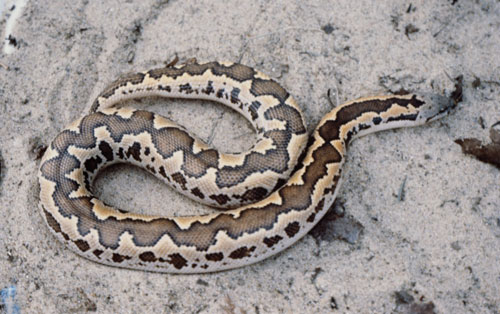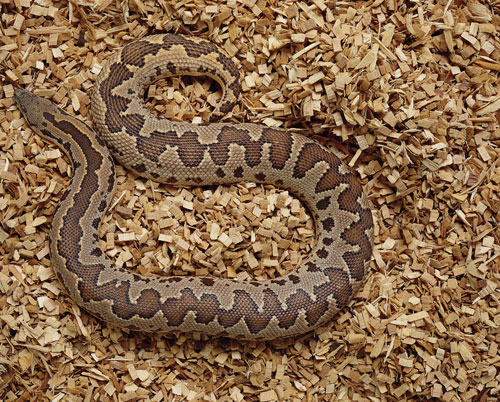The rough-scaled sand boa is a good choice for the beginner or advanced herpetoculturist.
Sand boas are small, with adults ranging from 18 to 48 inches in total length, and they are heavy-bodied constrictors, with short tails and small heads. These cryptically colored, fossorial boas are nocturnal and can typically be found in arid, semi-desert areas. They inhabit southeastern Europe, Africa and western Asia, including Pakistan and India. They are cylindrical in shape, with shovel-like snouts to aid in burrowing. Their small eyes are located toward the top of the head, and this adaptation is especially beneficial because they spend large periods of time buried with only their eyes and nose protruding through sand or loose soil. This is how they lie-and-wait for prey. In the wild, prey consists of small mammals, lizards, birds and even insects.

Photo Credit: Dave Fogel
The native habitat of the rough scaled sand boa includes southeastern Europe, Africa and western Asia, including Pakistan and India.
Sexual dimorphism exists in certain sand boa species, such as the rough-scaled (Eryx conicus) and the Egyptian (Eryx colubrinus), with the females being considerably larger than the males. The majority of sand boas are ovoviviparous. The Tartar sand boa (Eryx tataricus) can produce as many as 34 young. Most species for which data exists breed biennially.
Captive Husbandry of Sand Boas
Captive husbandry for commonly maintained sand boa species, such as Eryx colubrinus, E. conicus and E. johni, seems to vary little. The appropriate terraria size for most adults is between 10 to 20 gallons. These fossorial boas require little vertical space, and adults can also be maintained in transparent, shallow plastic tubs, such as Rubbermaid. Juveniles can be maintained in 2.5- to 5-gallon terraria or in modified plastic shoebox or sweaterbox enclosures. A heat pad or heat tape should be located beneath one-third to one-half of the enclosure. The heating device should be regulated to produce a substrate temperature between 80 to 90 degrees Fahrenheit. The hotspot should be 90 degrees, and the ambient temperature should be 80. For precise control, use a rheostat or temperature-control device in conjunction with the heat source. Additionally, this will allow the temperature to be lowered slightly at night if desired. Year-round, nightly temperature reductions are not necessary for sand boa health or captive propagation. Adequate relative humidity (a minimum of 50 to 65 percent) should be provided to insure proper shedding.

Photo Credit: Dave Fogel
These boas should have a substrate that will allow them to burrow, as it is their nature to do so.
These boas should have a substrate that will allow them to burrow, as it is their nature to do so. Enclosures consisting of a paper or paper towel substrate and a hide box are not suitable for sand boas. Sand or fine gravel is adequate, but labor intensive to properly maintain. Additional substrate material, including relatively dustless, finely processed wood chip products or aspen bedding also work well. The substrate should cover the entire floor of the enclosure. A depth of 2 to 4 inches is ideal for adult specimens. A small to medium, flat-bottomed ceramic water bowl measuring 5 to 7 inches in diameter must be incorporated into the enclosure, as sand boas will periodically drink from the bowl. Place it on the actual bottom to prevent boas from burrowing beneath it.
Rough-Scaled Sand Boa Nutrition
Neonate sand boas will typically feed on pink mice shortly after their first ecdysis, and can be fed every seven to 10 days. Growth is relatively rapid, and within two to three months, fuzzy mice can be fed to the juvenile. One-week to ten-day intervals between feedings is also an adequate schedule for juveniles. Sand boas are sedentary, and adults require no more than a meal every two to three weeks. Three- to four-week-old mice are an ideal size to feed adults, which are 2 to 3 feet in length.
Although some specimens will accept food in well-lit conditions, it is advisable to offer mice in the evening or under red lights because they are primarily nocturnal. A food item can be placed in the enclosure just prior to the lights being turned off. With most individuals, freshly killed rodents will be accepted. Although I do not feed previously frozen prey, if you wish to do so, simulated movement is recommended.
The Rough-Scaled Sand Boa
The rough-scaled sand boa (Eryx [Gongylophis] conicus) is also known as the common sand boa and Russell's earth boa, as adult specimens are sometimes mistaken for the venomous Russell's viper (Vipera [Daboia] russelii). Eryx conicus is found throughout India (excluding the northeast and the Andaman and Nicobar Islands), Pakistan, Nepal, Bangladesh and Sri Lanka, and it has been a popular species among herpetoculturists for several decades. The total length for adult Erxy conicus can measure 19 inches for males and 37 inches for females.

Photo Credit: Dave Fogel
Sand boas are small, with adults ranging from 18 to 48 inches in total length.
Captive Reproduction
On August 25, 1989, I obtained a juvenile (2-week-old) pair of rough-scaled sand boas from a private breeder. Both snakes fed shortly after being introduced into their new enclosures. Each of the boas has been housed individually in 10-gallon enclosures with a full-screen cover. A 2-inch deep substrate of finely processed, tiny wood chips was provided.

Photo Credit: Dave Fogel
Substrate should cover the entire floor of the enclosure. A depth of 2 to 4 inches is ideal for adult specimens
A 5-inch ceramic bowl filled with clean water was accessible at all times. The ambient temperature of the room was 80 degrees Fahrenheit, with a relative humidity of 75 to 80 percent. In addition, the rear third of the terraria rested on a heat tape covered with 4 inch wide aluminum flashing for better heat dissipation, which allowed the boas access to a hotspot. The hotspot was typically utilized after feeding or when the boas were "in-the-blue" (nearing their time to shed). The heat tape was connected to an automatic timer, which activated the tape in the morning, and turned it off at night.
For the first breeding attempt, a temperature cycling period was initiated early November 1992. This consisted of gradually (over a period of seven days) reducing the ambient air temperature to 72 to 74 degrees for two weeks. At the conclusion of this period, the ambient day temperature was gradually increased back to 80 degrees. A nightly temperature drop to 72 degrees was continued though mid-January. The heat tapes were discontinued during this cycling period. A fellow breeder mentioned successfully cycling E. conicus at temperatures of 65 to 68 degrees for periods of 50 to 63 days.
The female E. conicus was moved to a 20-gallon (long) terrarium with the wood litter substrate, a full-screen cover and water bowl. I believed the larger enclosure could better accommodate breeding activity. Late November, the male was introduced into the female's enclosure. Approximately two weeks after introduction, the male was observed crawling along the back of the female, aligning his body with hers. During this interaction, the female remained beneath the substrate. Copulation was observed in mid-December. During intromission, both boas remained completely buried in the substrate with only their tails protruding at a 90-degree angle to the enclosure floor.
After copulation, when breeding interest had ceased and the male was removed, a galvanized metal heat pad was positioned beneath one half of the terrarium to provide additional heat for the female should it be desired. The heat pad operated 24 hours a day. During the gestation period, the female would utilize the hotspot for as many as 12 consecutive hours. This is typical behavior, as additional heat is usually required for proper development of boa young.
Throughout the gestation period, the female rough-scaled sand boa never refused food. Small mice were fed at approximately three- to four-week intervals. The last meal offered was accepted only two weeks prior to giving birth.
Parturition occurred April 23, 1993. Eight flawless neonates were discovered in the enclosure after the room's lights were switched on. The number of young is consistent with other recorded births. Additional sources provided by zoological institutions and private breeders recorded 21 litters, with neonates ranging in number from seven to 12. Unlike many boa species, where larger females produce a greater number of offspring, E. conicus litters remain small, even in larger females. However, larger females tend to produce larger neonates.
Following an additional temperature cycling period where I cooled them yet again in early November, copulation was observed in the same single pair during January 1994, with both male and female completely on top of the substrate during intromission. Parturition occurred June 6, 1994.
These breeding are not typical, as they involved only a single pair of sand boas. Using multiple males is beneficial for boa breeding and typically greatly increases the chances of success. According to literature, and records supplied by private breeders, rough-scaled sand boas usually give birth in late May through August. This coincides with recorded copulation dates during mid-March. My breeding success has shown Eryx conicus can be temperature cycled earlier, resulting in earlier copulation, and parturition.
Caudal Luring
Caudal luring is a feeding strategy primarily employed by snakes, which involves the tail tip being waved, or undulated, to attract a prey animal within striking range. I have observed this behavior in the boa constrictor, death adder (Acanthophis spp.), and Agkistrodon species. Death adders possess a modified tail tip, which sports a spur-like scale and is typically colored differently than the body. As juveniles, several Agkistrodon species have a light-colored tail tip. Many boa constrictor specimens have numerous bright blotches on the tail. These adaptations are thought to aid in caudal luring.
Hoser (2005) describes tail thrashing in Australian elapids as a sign of arousal and excitement, and differentiates this behavior from caudal luring. His description involves the tail being held stiffly off the ground and thrashed strongly in a side-to-side motion. He explains that the thrashing is clearly not in a manner to attract food.
On March 2, 2006, while feeding a 17-year-old, female, captive-produced Eryx conicus, I observed a similar behavior. A stunned rat pup/hopper (eyes open for approximately two days) was placed in the boa's enclosure. The rat hopped on and then off the back of the boa. This immediately prompted the boa to frantically wave/whip its tail, along with approximately the posterior 25 percent of its body. In my more than 20 years of maintaining, and reproducing rough-scaled sand boas, this is the only observed instance of this behavior, and it was clearly triggered by the presence of food. It may be the first observation of this behavior in a fossorial boid species.
Hearty and Interesting
To this day, I continue to maintain my original adult pair, as well as a pair of their offspring produced in 1993. Rough-scaled sand boas make excellent captives. Their interesting lifestyle, small size, hardiness, ease of propagation and low-maintenance requirements make them a good choice for the beginner or advanced herpetoculturist.
Dave Fogel authored the book Captive Husbandry and Propagation of the Boa Constrictors and Related Boas, and he has written numerous articles for publications including REPTILES magazine, Reptiles USA, The Vivarium, Captive Breeding and Reptile and Amphibian Magazine.


